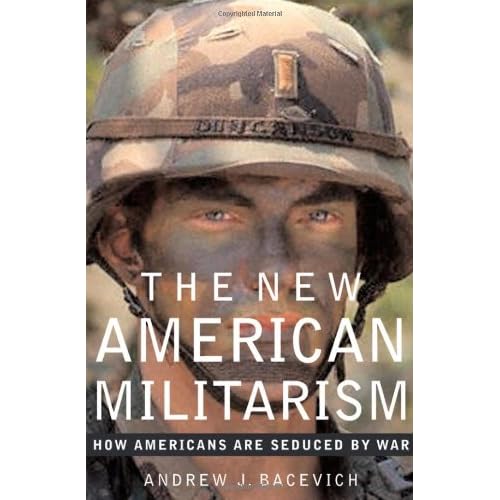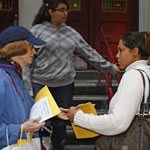2003-05-03
Jorge Mariscal -
"Lethal and Compassionate" The Militarization of US Culture
The story of Jesus Gonzalez is a cautionary tale for the future. A young Chicano born in Mexico and raised in California, Gonzalez grew up surrounded by relatives who were active in the United Farm Worker’s, the labor union founded by pacifist Cesar Chavez. In high school, he organized against Proposition 187, the anti-immigrant initiative, and in support of Native American environmental causes. Despite his early childhood formation within progressive circles, Gonzalez surprised everyone who knew him when he decided to drop out of college because he had to be a marine. "I know school is important," he told his parents, "but I need to do this" (Jennifer Mena, "Fallen Marine Is Recalled as Pacifist, Activist," L.A. Times 4/24/03).
In the simple phrase "But I need to do this" lie the dire consequences of militarization’s power and success. Drawing upon distorted notions of masculinity, the glamour of the uniform, and the myth of rugged individualism, military recruitment ads-a solitary marine scaling the face of a mountain, for example-cast a spell to which working class youth are especially susceptible. A relative lack of economic and educational opportunities seals the ideological deal. In Gonzalez’s case, the fantasy of military service simply overwhelmed the humanistic values with which he had been raised. On April 12, 2003, he was killed by small arms fire at a checkpoint somewhere in Iraq.
Scholar John Gillis contrasts older forms of militarism in which civil society is separate and subordinate to military authority with contemporary militarization. According to Gillis, militarization is the process by which "civil society organizes itself for the production of violence." Whereas militarism once was understood as a set of beliefs limited to specific social groups or sectors of the ruling class, militarization is a series of mechanisms that involve the entire social edifice.
In liberal democracies in particular, the values of militarism do not reside in a single group but are diffused across a wide variety of cultural locations. In twenty first-century America, no one is exempt from militaristic values because the processes of militarization allow those values to permeate the fabric of everyday life.
Examples are numerous and I will name only a few. The incursion of military recruiters and teachings into the public school system is well known. The proliferation of JROTC units in American schools began in the early 1990s and continues today. Television spots, print ads, and websites for all the service branches are sophisticated marketing tools designed to attract young people who are unsure of their future.
At marines.com, for example, after the initial sounds of gunfire open the home page the potential recruit reads: "At the core of every Marine is the warrior spirit, a person imbued with the special kind of personal character that has defined greatness and success for centuries. And in this organization, you will be regarded as family." "You are special, you are a fighter, we will take care of you"–this is an especially seductive message for young men and women without economic privilege and who often do not enjoy stability at home.
For middle class suburban youth, one of the fastest growing "sports" is "paintball" in which teenagers stalk and shoot each other on "battlefields" (In San Diego, paintball participants pay an additional $50 to hone their skills at the Camp Pendleton Marine Base). Far from the figurative violence of popular culture, the Bush administration is rewriting nuclear arms policy and plans to militarize outer space are moving forward without public scrutiny. At the level of media ritual, the president favors speaking to captive audiences at military bases, defense plants, and on aircraft carriers.
These and other practices that glorify the instruments of real and symbolic violence will have unforeseen and long-term consequences. In the meantime, billions of dollars for the military-corporate-educational complex ($399 billion for the Pentagon alone according to the administration’s FY2004 Discretionary Budget Request), color-coded "terrorist alerts," police and "homeland security" raids on immigrant communities, and FOX news bulletins for even the most mundane Defense Department briefing all work to create a climate of fear and anxiety that is unprecedented in U.S. history.
If we feel less safe today than ever before, it is because the entire culture has organized itself with the dual objective of either perpetrating violence or defending itself from violence. Given the current administration’s proposed budget cuts (including major reductions in veterans’s benefits), it appears that self-defense is a less worthy objective than arsenal building. One commentator recently put it this way: "George W. Bush has inspired new terrorist threats to the United States–according to the official testimony of his own CIA–where none existed. At the same time, he purposely starves those localities and institutions on which the complex and expensive task of terrorist protection ultimately falls and yet the increasingly Foxified media tell a story only of heroism: of the US military, of the American people and of the President of the United States, who has so far managed to avoid service to either one" (Eric Alterman, "Bush goes AWOL," The Nation 4/17/03).
In the United States, where elaborate formal structures of representative democracy, a free press, and pluralism exist (at least on paper), militarization’s primary structures must take shape through lies and the obfuscation of reality. The Bush administration has taken the art of the lie and the control of information, strategies that sustain all large bureaucracies, to a new level. Colin Powell’s performance at the United Nations before the invasion of Iraq was only the most spectacular example of the Bush regime’s willingness to lie to the world.
Frustrated by the pattern of deceit that led to the invasion of Iraq, a leading economist writing in the New York Times was compelled to pose the question: "Aren’t the leaders of a democratic nation supposed to tell their citizens the truth?" (Paul Krugman, "Matters of Emphasis," 4/29/03). Or as one journalist predicts: "We’re heading for big trouble as a nation if we aren’t even concerned that our heads of state may be manipulating us by manipulating the truth. In a nation where hypocrisy is rewarded, expect more lies" (Robert Steinback, "Did Our Leaders Lie to Us? Do We Even Care?," Miami Herald 4/30/03).
Militarization and open democratic societies, then, do not make a good match, the former producing pathologies at both the individual and collective levels. The face of militarization on the ground is perhaps most disturbing insofar as it reveals a disconnected hardening of individuals to human suffering. The most highly militarized sector of U.S. society-the armed forces -attempts to deny this by concocting a self-image premised on humanitarian concern for their victims. From Secretary of Defense Rumsfeld down to officers in the field, the illusion is that the U.S. military is the most effective and destructive in history even as it is the most concerned with avoiding civilian deaths.
From this bizarre cocktail of contradictory missions comes the novel phase "lethal and compassionate." The phrase is deployed to erase from the historical record hundreds of Iraqi and Afghan civilian casualties (the exact number of which we will never know) or to congratulate ourselves for airlifting an Iraqi boy to a hospital in Kuwait. There is no mention of the "lethal" side of the equation-the fact that the boy lost his entire family and both his arms to U.S. bombs.
"Lethal and compassionate" may work as a public relations slogan and a psychological sleight of hand for some in the military but recent accounts of combat in Iraq suggest that the brutality of warfare cannot be sanitized for long. Simply read Peter Maass’s devastating description of marine activities near Baghdad in which two journalists report how a squad leader, after his troops fired on several civilian vehicles, shouted: ”My men showed no mercy. Outstanding” ("Good Kills." New York Times 4/20/03) or the admission by recently returned marine reservist Gus Covarrubias that he executed in cold blood two Iraqi prisoners because some marines had been shot and "The Marines are my family" ("Marine Discusses Execution-Style Killing," Associated Press 4/26/03).
Or consider the case of Sgt. 1st Class Jeff Lujan who gave the order to shoot into a civilian truck at a checkpoint only to discover that his men had killed a woman and a young girl. "I’ve reconciled myself," Lujan said. "We did the right thing, even though it was wrong" (Geoffrey Mohan, "Memories Don’t Die So Easily," New York Times 4/18/03). For other GIs, militarized values will not be reconciled so easily with the values instilled by family and church. The psychic and social costs of these dreadful ironies are hidden in a flurry of flag-waving and patriotic zeal.
As James Carroll brilliantly put it: "Photographic celebrations of our young warriors, glorifications of released American prisoners, heroic rituals of the war dead all take on the character of crass exploitation of the men and women in uniform. First they were forced into a dubious circumstance, and now they are themselves being mythologized as its main post-facto justification — as if the United States went to Iraq not to seize Saddam (disappeared), or to dispose of weapons of mass destruction (missing), or to save the Iraqi people (chaos), but ”to support the troops.” War thus becomes its own justification. Such confusion on this grave point, as on the others, signifies a nation lost" ("A Nation Lost," Boston Globe 4/22/03).
Assuming the nation is not beyond redemption, people of good will who opposed the American invasion of Iraq ought to consider turning their attention to the long-term consequences of militarization. Unless militarization is systematically exposed and resisted at every site where it appears in the culture there will be more young men and women who follow the path of Jesus Gonzalez. What should become of the antiwar movement now? Perhaps yet another march and demonstration will prove less productive than focusing our energy on devising strategies to slow down a process that threatens both the future of our children and the soul of the nation.
JORGE MARISCAL is a member of Project YANO, a San Diego-based organization made up of veterans and activists who are working to demilitarize our schools.He can be reached at: This email address is being protected from spambots. You need JavaScript enabled to view it.
Source: http://www.counterpunch.org/2003/05/03/the-militarization-of-us-culture/
 Counter-recruitment essentials
Counter-recruitment essentials

 LINCOLNSHIRE, Ill. — Brian Berman, a senior at Stevenson High School, doesn't want to join the military, doesn't want calls from recruiters, doesn't want them at his door.
LINCOLNSHIRE, Ill. — Brian Berman, a senior at Stevenson High School, doesn't want to join the military, doesn't want calls from recruiters, doesn't want them at his door.
 The
The 



 The warning, given to me 25 years ago, came at the moment Pat Robertson and other radio and televangelists began speaking about a new political religion that would direct its efforts at taking control of all institutions, including mainstream denominations and the government. Its stated goal was to use the United States to create a global, Christian empire. It was hard, at the time, to take such fantastic rhetoric seriously, especially given the buffoonish quality of those who expounded it. But Adams warned us against the blindness caused by intellectual snobbery. The Nazis, he said, were not going to return with swastikas and brown shirts. Their ideological inheritors had found a mask for fascism in the pages of the Bible. - Chris Hedges (From his article:
The warning, given to me 25 years ago, came at the moment Pat Robertson and other radio and televangelists began speaking about a new political religion that would direct its efforts at taking control of all institutions, including mainstream denominations and the government. Its stated goal was to use the United States to create a global, Christian empire. It was hard, at the time, to take such fantastic rhetoric seriously, especially given the buffoonish quality of those who expounded it. But Adams warned us against the blindness caused by intellectual snobbery. The Nazis, he said, were not going to return with swastikas and brown shirts. Their ideological inheritors had found a mask for fascism in the pages of the Bible. - Chris Hedges (From his article: 



 David Swanson is the author of the new book, Daybreak: Undoing the Imperial Presidency and Forming a More Perfect Union, by Seven Stories Press and of the introduction to The 35 Articles of Impeachment and the Case for Prosecuting George W. Bush by Dennis Kucinich. In addition to cofounding AfterDowningStreet.org, he is the Washington director of Democrats.com and sits on the boards of a number of progressive organizations in Washington, DC.
David Swanson is the author of the new book, Daybreak: Undoing the Imperial Presidency and Forming a More Perfect Union, by Seven Stories Press and of the introduction to The 35 Articles of Impeachment and the Case for Prosecuting George W. Bush by Dennis Kucinich. In addition to cofounding AfterDowningStreet.org, he is the Washington director of Democrats.com and sits on the boards of a number of progressive organizations in Washington, DC. Jorge Mariscal is the grandson of Mexican immigrants and the son of a U.S. Marine who fought in World War II. He served in the U.S. Army in Vietnam and currently teaches at the University of California, San Diego.
Jorge Mariscal is the grandson of Mexican immigrants and the son of a U.S. Marine who fought in World War II. He served in the U.S. Army in Vietnam and currently teaches at the University of California, San Diego. Matt Guynn plays the dual role of program director and coordinator for congregational organizing for On Earth Peace, building peace and nonviolence leadership within the 1000+ congregations of the Church of the Brethren across the United States and Puerto Rico. He previously served a co-coordinator of training for Christian Peacemaker Teams, serving as an unarmed accompanier with political refugees in Chiapas, Mexico, and offering or supporting trainings in the US and Mexico.
Matt Guynn plays the dual role of program director and coordinator for congregational organizing for On Earth Peace, building peace and nonviolence leadership within the 1000+ congregations of the Church of the Brethren across the United States and Puerto Rico. He previously served a co-coordinator of training for Christian Peacemaker Teams, serving as an unarmed accompanier with political refugees in Chiapas, Mexico, and offering or supporting trainings in the US and Mexico. Rick Jahnkow works for two San Diego-based anti-militarist organizations, the Project on Youth and Non-Military Opportunities and the Committee Opposed to Militarism and the Draft. He can be reached at:
Rick Jahnkow works for two San Diego-based anti-militarist organizations, the Project on Youth and Non-Military Opportunities and the Committee Opposed to Militarism and the Draft. He can be reached at:  Pat Elder was a co-founder of the
Pat Elder was a co-founder of the 
 Edward Hasbrouck grew up in Wellesley, Massachusetts, a suburb of Boston. He considers myself primarily a political activist. Hasbrouck began his resistance to the violence of illegitimate authority as an elected but nonvoting student representative to the local school board and as an activist for peace, disarmament, and students' rights. His first book was a handbook for high school students on their legal rights co-authored in the summer of 1977, between high school and college, as an intern for the student service bureau of the Massachusetts Department of Education. He majored in political science at the University of Chicago until leaving school to pursue direct involvement in political activism.
Edward Hasbrouck grew up in Wellesley, Massachusetts, a suburb of Boston. He considers myself primarily a political activist. Hasbrouck began his resistance to the violence of illegitimate authority as an elected but nonvoting student representative to the local school board and as an activist for peace, disarmament, and students' rights. His first book was a handbook for high school students on their legal rights co-authored in the summer of 1977, between high school and college, as an intern for the student service bureau of the Massachusetts Department of Education. He majored in political science at the University of Chicago until leaving school to pursue direct involvement in political activism.




